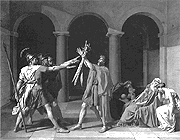| back to: Chapter 5 | Reason and Revolution |
| PREFACE TO ROCOCO
There was a concerted move by Louis XIV to "rationalize" his reign and make associations to the former Holy Roman Emperorship. After all, Charlemagne, one of his predecessors, had been crowned "King of the Franks and Holy Roman Emperor" in 800 AD. Louis made these associations by surrounding himself and his court with all things "Classical." He established the Royal Academy of Painting and Sculpture to make the focus of art in France one which was also based on "Classical" forms. Classical ideas had created the foundation for Western thought, morality, and society. It also indicated that his reign was built on lofty ideals.In principle this may have been true, but Louis lived extravagantly, building the palace at Versailles with its sprawling gardens. He also spared no expense in his affairs of State, hoping to influence visiting dignitaries. Louis also took control of France's political aristocracy by forcing them to live at Versailles. This insured that they would be following his direction by helping to promote his Classical vision. |
 Embarkation for the Island of Cythera |
-sometimes called the style of Louis XV (15th)
Antoine Watteau (1684-1721)
Jean Honore Fragonard
Francois Boucher
|
 Oath of the Horatii Death of Marat Monticello |
NEOCLASSICISM
France
More serious in its nature, a reaction against Rococo and the morals of Louis XV
Jacques-Louis David (1748-1825)
Oath of the Horatii- 1784-5, oil on canvas, 14'x 11'
Death of Marat- 1793, oil on canvas, 5'3"x 4'1"
Jean-Auguste-Dominique Ingres (1780-1867) -was government-appointed painter for Napoleon. Grande Odalisque- 1814, oil on canvas, 3'x 5'4"
United States
Thomas Jefferson (1769-84) Monticello- 1769-84, Charlottesville, VA
|
|
Raft of the Medusa Liberty Leading the People Executions on the Third of May, 1808 |
ROMANTICISMPainting
Edmund Burke
Theodore Gericault (1791-1824)
Raft of the Medusa, 1819, oil on canvas, 16'x 23'6"
Eugene Delacroix (1798-1863)
Liberty Leading the People, 1830, oil on canvas, 8'6"x 10'7"
Death of Sardanapalus, 1826, oil on canvas Arabs Skirmishing in the Mountains, c. 1834, oil on canvas Francisco de Goya
Executions on the Third of May, 1808, 1814, oil on canvas, 8'9"x 11'4"
Prints: Etchings include a series called the "Horrors of War" Romantic Landscape Painting
The Pre-Raphaellite Brotherhood |
| Next study guide: Chapter 7 |

Custom Search
|